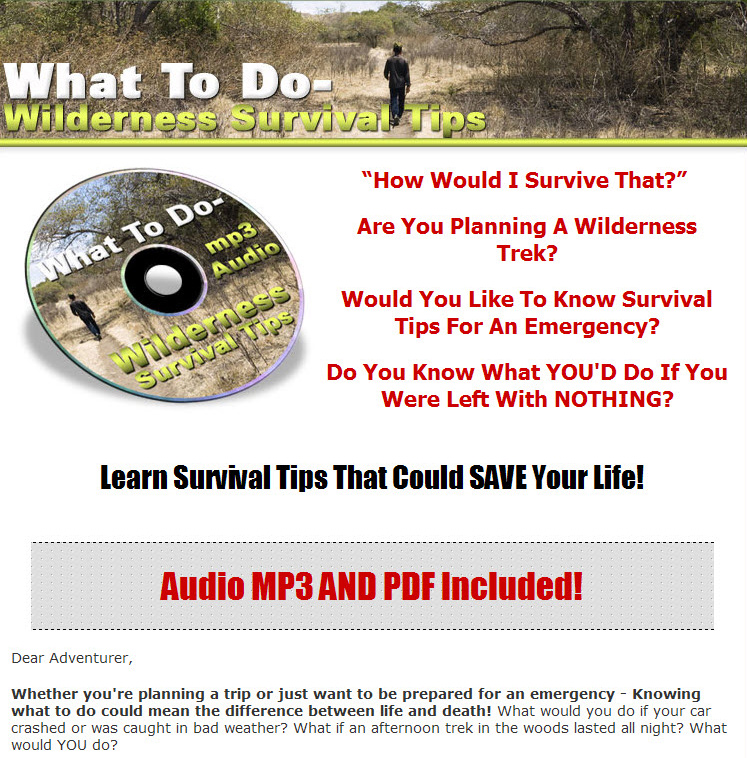Salespage Snapshot

PLR Ebook With Audio Table Of Contents
The Dangers of the Wilderness 4
What to Do Before Planning a Wilderness Trek 6
What to Do if You Are Lost Without Emergency Supplies 8
How to Survive in a Vehicle 10
How to Build a Fire in the Wilderness 12
How to Prepare a Shelter in the Wilderness 14
How to Help Rescuers Find You 16
Survival Tips for Winter Weather 18
Survival Tips for Summer Weather 20
What to Wear When Hiking in the Wilderness 22
What Emergency Supplies You Should Carry 24
Best Food and Water Supplies to Bring 26
How to Find Food and Water if You Don’t Have Any 28
How to Treat Minor Injuries in the Wilderness 30
How to Face Your Fear if You Are Lost in the Wilderness 32
Ebook Sample Content Preview
The Dangers of the Wilderness
There are many dangers in the wilderness and some of them are only tiny so we don’t think of them. Bears and other large, dangerous animals are quite evident and usually we are prepared to encounter and deal with them. We may even remember to keep a watch out for snakes, but what about insects such as bees, wasps and spiders?
Dangerous insects are deadly because they know no fear. You can’t chase away a hive of angry bees or wasps by yelling at them, or even escape by shooting them. Spiders can crawl into clothing and remain unnoticed until they deliver their fatal bite. There are even hidden dangers in the water that you can tread on. Certain small fish or shellfish have the potential to deliver a nasty or even fatal sting if trodden on.
You should always wear shoes in the water and walk with sliding motion rather than lifting your feet up and down. This will help prevent placing your feet down on any kind of animal that may sting or bite.
There are also poisonous plants and fungi to watch out for. Plants can poison or sting by touching the skin, by ingestion – if we eat them – or by absorption of sap into the skin. Sometimes the sting is painful but not lethal and other times it is only lethal if we are allergic to them. Stinging nettles often grow along riverbanks and in ferny gullies. They are not toxic but can cause a painful sting that lasts for hours.
Never trust that what an animal eats will be all right for you to eat. While this theory is true in general, there are some plants that are poisonous to humans that animals do eat. Very often some parts of a plant are poisonous while others are not. For instance the fruit may be all right while the leaves or stem could be poisonous. Other times a plant can be poisonous during certain seasons but not in others.
In general, you should avoid eating all mushrooms. Some are highly toxic and it’s not worth the risk involved. Other plants such as poison ivy, poison oak, poison sumac, trumpet vine and the rengas tree cause contact dermatitis. If you touch any of these, wash the affected area with cold water and soap. If you have none, wipe it repeatedly with dirt to remove the oil. But if blisters come up, keep the area clean or dirt could infect them…
Other Details* Sales Page: Included, HTML
* File Format: MS Word Doc, PDF
* Number of Pages: 33
* Included Graphics: Ecovers, PSD, JPG
* Download File Size: 36,137 KB













